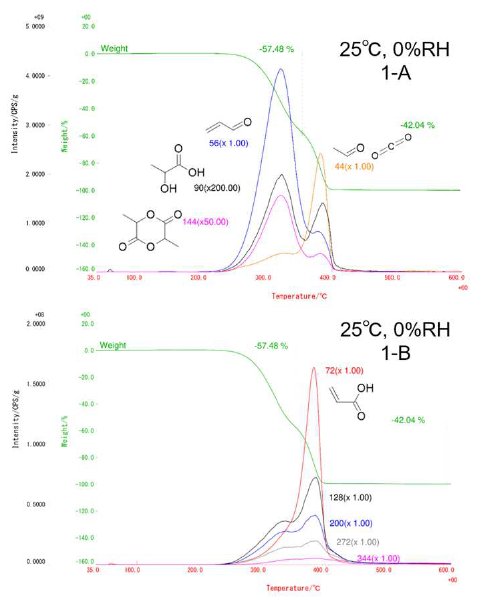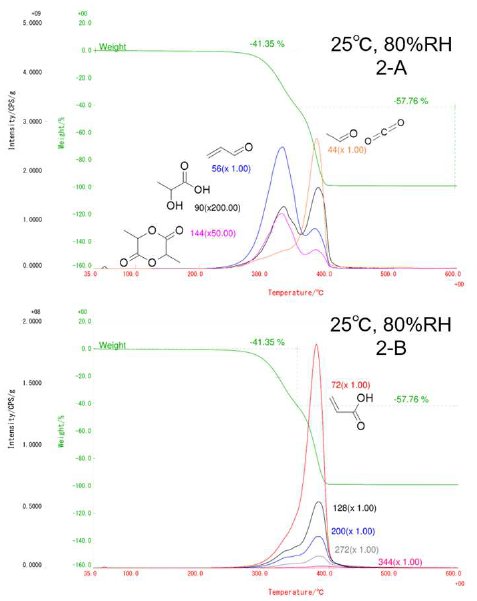Qualitative Analysis of Biopolymer in Humidity Atmosphere by HUM-STA-MS
Introduction
Biopolymers are known to be sensitive to moisture conditions during storage where continuous exposure to humidity causes hydrolysis in the material. In this application, we demonstrate the use of humidity controlled atmosphere (HUM-1) in STA connected to a GCMS system to detect changes in thermal decomposition behavior and evolution of gaseous compounds in poly-D,L-lactide as affected by water vapor atmosphere.
Measurement and results
Approximately 1 mg sample amount placed in a Pt pan and an empty Pt pan as reference were loaded into a horizontal differential type STA connected to a GCMS system for direct coupling measurement. The sample was heated from RT to 600℃ at 20℃/min under a constant water vapor atmosphere of 25℃, 0%RH (dry) and 25℃, 80%RH (2534Pa or wet). Electron ionization mode in MS was used for detecting evolved gases scanning in the range of m/z 10-500. The HUM-STA-MS measurement result of Poly-D,L-lactide in dry and wet atmosphere are shown in Figure 1 and Figure 2, respectively.

Figure 1: Mass ion thermogram of gases detected from dry atmosphere. (Numbers in parenthesis indicate magnification)

Figure 2: Mass ion thermogram of gases detected from wet atmosphere. (Numbers in parenthesis indicate magnification)
TG results revealed a two-stage overlapping mass loss which can be observed at 200~350℃ and at 350~500℃. In dry atmosphere, the respective first and second stage mass losses are 57.48% and 42.04%. The evolved gases that were detected at 200~350℃ are m/z 56, 90, 144 which are derived from acrolein (mw 56), lactic acid (mw 90) and lactide (mw 144) as shown in Figure 1A, while the evolved gases that were detected from 350~500℃ are m/z 72, 44 revealed as acrylic acid (mw 72) and acetaldehyde or carbon dioxide (mw 44). Oligomers were also detected as well. However, in the wet atmosphere in Figure 2A and 2B, the first and second mass losses have changed to 41.35% and 57.76%. The detected gases in Figure 2A at 200~350℃ namely acrolein, lactic acid and lactide have decreased in intensity as humidity has increased to 80%RH due to hydrolysis while the evolved gases at the high temperature region in Figure 2B showed less changes except for m/z 90. The results of this experiment strongly suggest that biopolymer such as poly-D,L-lactide is susceptible to humidity concentrations and must be stored at room temperature with low relative humidity or dry condition.

Contact Us
Whether you're interested in getting a quote, want a demo, need technical support, or simply have a question, we're here to help.
